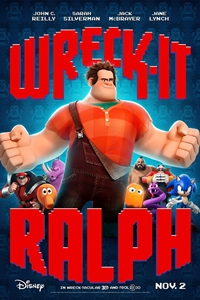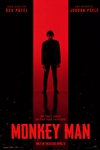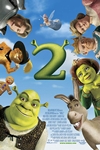Wreck-It Ralph (PG) ★★★★
 Wreck-It Ralph lives in an arcade, and while that may be a longstanding fantasy for many of the children of the 80s, the shine has more than worn off for Ralph. He resides in a videogame called Fix-It Felix and has been executing the same program for thirty years. Pursuant to the game's 8-bit edict, he must endeavor to destroy an apartment building as a quirky little do-gooder with a hammer tries to repair it. Ralph is a badguy, but is he a bad guy? Feeling out of order, he flees the world he knows to see if he can take his unfulfilling existence to the next level.
Wreck-It Ralph lives in an arcade, and while that may be a longstanding fantasy for many of the children of the 80s, the shine has more than worn off for Ralph. He resides in a videogame called Fix-It Felix and has been executing the same program for thirty years. Pursuant to the game's 8-bit edict, he must endeavor to destroy an apartment building as a quirky little do-gooder with a hammer tries to repair it. Ralph is a badguy, but is he a bad guy? Feeling out of order, he flees the world he knows to see if he can take his unfulfilling existence to the next level.
At a cursory glance, Wreck-It Ralph may seem to offer nothing to anyone bereft of a passion for classic gaming. Truth be told, there are ample references to games and gaming characters, and not without a deep and knowledgeable affection. The jokes don't come from the mere appearance of these characters, but also videogame fundamentals actually permeate into the traits of the film's original characters. In fact, possibly the most thoughtful nod to gaming is the jerky movements of the characters within the Fix-it Felix cabinet, superbly calling back to the limited range of motion afforded to 80s-era arcade fodder. It's a balance of overt reference and the methods by which various gaming trademarks play into Wreck-It Ralph's overarching universe.
And that universe is precisely what will draw in even those who have never held a controller. The landscapes through which Ralph travels are varied and gorgeous: from his modest, but charming 8-bit home to the dark and foreboding nightmare of Hero's Duty, and finally to the garish wonderment of Sugar Rush. There are so many styles and applications of animation at work, each dedicated to the conceptual scenery changes. You don't need to know how to play Tapper, or even that it ever existed as a real game, to recognize that his almost stop-motion movements clash delightfully with the CG Ralph. And no Halo or Mario Kart knowledge required to understand the depth of detail in the worlds of Hero's Duty and Sugar Rush, respectively.
But like any hardcore gamer will attest, great games cannot live by rich environments alone. The best games, like the best movies, are founded upon remarkable characters. Ralph may be a arcade videogame villain, but his appeal is as broad as his building-leveling shoulders. He represents that need in all of us to rise above our station, to challenge the notion that we are predestined to one occupation or personality set. Ralph is a guy who's bad because he's programmed to be, but he is constantly looking at the life he wants--the life of a hero--from the other side of the glass, literally in fact. It's a sweetly relatable theme that finds its way into other characters like Ralphs pint-sized nemesis Vanellope. It is from this theme that the movie derives the majority of its heart.
The voice cast here is exceptional, but that should come as no surprise considering the characters seem modeled after the personalities of the performers selected, or at least modeled after the characters they tend to portray. Ralph, brought to life by John C. Reilly, is a perennial sad sack with an awkward sense of humor that is somehow endearing. Voiced by Sarah Silverman, Vanellope is a shrill, snarky troublemaker who manages to be adorable despite herself. Felix is a dopey, but sincere yokel…voiced by 30 Rock's Jack McBrayer. Jane Lynch voices the bossy, domineering female soldier with the endless vocabulary of put-downs. Need we say more? That's not to say this approach is lazy; far from it. It gives the characters a fleshed-out, lived-in quality.
Wreck-It Ralph significantly narrows the gap between Disney and Pixar in terms of excellence. It still seems strange to think of Disney and Pixar as two separate bodies, but the fact is that as soon as Pixar made the choice to stand alone, their films have outshined Disney's by a considerable margin. Wreck-It Ralph borrows liberally from the Pixar playbook, evident right from the moment the central conceit is revealed to be the bestowing of sentience and personality to inanimate entities. And like Pixar, Wreck-It Ralph is at its most enjoyable and most clever when the audience experiences the functional mechanics of how these characters exist in their own world, the specificity of their imagined living space and its logistics. Yet this time, Disney has dug deeper than the amiable outward trappings and arrived at what makes us love the films of Pixar, and quality family entertainment in general.
If there is a complaint to be had with Wreck-It Ralph, it is merely that it introduces a fascinating and thoroughly entertaining concept, and then limits itself to but a few outlets for its expression. The movie spends so much time in Sugar Rush and, while it's beautiful and captivating, we wonder what the other games would have had to offer. It's akin to Monday morning filmmaking, "I would've done this" or "I would've done that," but it would have been the cherry on the sundae, or perhaps more appropriately the various fruits in the maze, to have been able to witness Ralph's interaction with other games.
By the time we reach the kill screen, Wreck-It Ralph has used something as geeky and esoteric as the world of arcade gaming to warp us to a place of emotional resonance and utter delight. Suffice to say, it has plenty of replay value.
Hollywood.com rated this film 4 stars.
To get the full Quicklook Films experience, uncheck "Enable on this Site" from Adblock Plus
box office top 10

Civil War Released: April 12, 2024 Cast: Kirsten Dunst, Wagner Moura 25.7M

Godzilla x Kong: The New Empire Released: March 29, 2024 Cast: Rebecca Hall, Brian Tyree Henry 15.5M

Ghostbusters: Frozen Empire Released: March 22, 2024 Cast: Paul Rudd, Carrie Coon 5.8M

Kung Fu Panda 4 Released: March 8, 2024 Cast: Jack Black, Viola Davis 5.5M

Dune: Part Two Released: March 1, 2024 Cast: Timothée Chalamet, Rebecca Ferguson 4.3M

Monkey Man Released: April 5, 2024 Cast: Dev Patel, Sikandar Kher 4.1M

The First Omen Released: April 5, 2024 Cast: Nell Tiger Free, Bill Nighy 3.8M

The Long Game Released: April 12, 2024 Cast: Dennis Quaid, Gillian Vigman 1.4M

Shrek 2 Released: May 19, 2004 Cast: Mike Myers, Eddie Murphy 1.4M

Sting Released: April 12, 2024 Cast: Alyla Browne, Ryan Corr 1.2M






